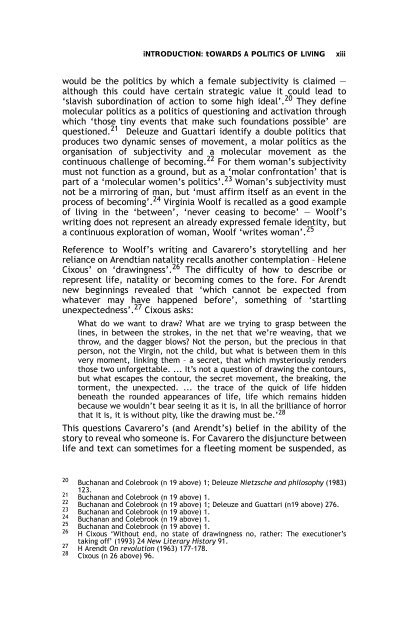Sex, Gender, Becoming - PULP
Sex, Gender, Becoming - PULP
Sex, Gender, Becoming - PULP
You also want an ePaper? Increase the reach of your titles
YUMPU automatically turns print PDFs into web optimized ePapers that Google loves.
iNTRODUCTION: tOWARDS A POLITICS OF LIVING<br />
xiii<br />
would be the politics by which a female subjectivity is claimed —<br />
although this could have certain strategic value it could lead to<br />
‘slavish subordination of action to some high ideal’. 20 They define<br />
molecular politics as a politics of questioning and activation through<br />
which ‘those tiny events that make such foundations possible’ are<br />
questioned. 21 Deleuze and Guattari identify a double politics that<br />
produces two dynamic senses of movement, a molar politics as the<br />
organisation of subjectivity and a molecular movement as the<br />
continuous challenge of becoming. 22 For them woman’s subjectivity<br />
must not function as a ground, but as a ‘molar confrontation’ that is<br />
part of a ‘molecular women’s politics’. 23 Woman’s subjectivity must<br />
not be a mirroring of man, but ‘must affirm itself as an event in the<br />
process of becoming’. 24 Virginia Woolf is recalled as a good example<br />
of living in the ‘between’, ‘never ceasing to become’ — Woolf’s<br />
writing does not represent an already expressed female identity, but<br />
a continuous exploration of woman, Woolf ‘writes woman’. 25<br />
Reference to Woolf’s writing and Cavarero’s storytelling and her<br />
reliance on Arendtian natality recalls another contemplation – Helene<br />
Cixous’ on ‘drawingness’. 26 The difficulty of how to describe or<br />
represent life, natality or becoming comes to the fore. For Arendt<br />
new beginnings revealed that ‘which cannot be expected from<br />
whatever may have happened before’, something of ‘startling<br />
unexpectedness’. 27 Cixous asks:<br />
What do we want to draw? What are we trying to grasp between the<br />
lines, in between the strokes, in the net that we’re weaving, that we<br />
throw, and the dagger blows? Not the person, but the precious in that<br />
person, not the Virgin, not the child, but what is between them in this<br />
very moment, linking them – a secret, that which mysteriously renders<br />
those two unforgettable. ... It’s not a question of drawing the contours,<br />
but what escapes the contour, the secret movement, the breaking, the<br />
torment, the unexpected. ... the trace of the quick of life hidden<br />
beneath the rounded appearances of life, life which remains hidden<br />
because we wouldn’t bear seeing it as it is, in all the brilliance of horror<br />
that it is, it is without pity, like the drawing must be.’ 28<br />
This questions Cavarero’s (and Arendt’s) belief in the ability of the<br />
story to reveal who someone is. For Cavarero the disjuncture between<br />
life and text can sometimes for a fleeting moment be suspended, as<br />
20<br />
Buchanan and Colebrook (n 19 above) 1; Deleuze Nietzsche and philosophy (1983)<br />
123.<br />
21 Buchanan and Colebrook (n 19 above) 1.<br />
22<br />
Buchanan and Colebrook (n 19 above) 1; Deleuze and Guattari (n19 above) 276.<br />
23 Buchanan and Colebrook (n 19 above) 1.<br />
24 Buchanan and Colebrook (n 19 above) 1.<br />
25<br />
Buchanan and Colebrook (n 19 above) 1.<br />
26 H Cixous ‘Without end, no state of drawingness no, rather: The executioner’s<br />
taking off’ (1993) 24 New Literary History 91.<br />
27<br />
H Arendt On revolution (1963) 177-178.<br />
28 Cixous (n 26 above) 96.
















